Michael's Long Box: The History of Variant Covers, Part One
The 90's comic book boom was fueled by many factors, but the main thrust came from an influx of buyers who began collecting not to read and enjoy, but rather to own and preserve in the hopes of earning a return on their investment. This gave rise to a speculator market, bolstered by novice collectors who neither understood the history of the hobby, nor why a copy of 1938's 'Action Comics #1' could be worth hundreds of thousands of dollars, but a newsstand copy of 1992's 'Youngblood #1' would take decades (at best) to exceed the value of its own $2.50 cover price. None of this really mattered to the comic companies though, who were more than happy to take anybody's money no matter the reason. "And what," these companies' marketing departments asked themselves, "was better than taking a consumer's money on a reliable monthly, or even weekly (depending on the title) basis?" The answer they came up with was, "taking a consumer's money several times over for the same story." Enter the variant cover.
Comic book publishers didn't invent the idea of plopping the same story between different cover pages, of course. Paperback publishers had found success doing so for decades, sometimes in a duplicitous fashion by re-titling an older story and providing new artwork to catch readers off-guard. Magazines likewise were no strangers to the practice, with TV Guide, Entertainment Weekly, and other mags frequently offering multiple covers to entice repeat purchase--franchises with long-standing and dedicated fandoms like Star Wars and Star Trek were the most frequent recipients of this treatment, but it can be seen today with the likes of Outlander and The Hunger Games. Even video games weren't immune to this, with Game Informer, EGM, GamePro, and PC Gamer frequently offering multiple covers even of standard issues for their readers, to say nothing of major 'event' themed issues or annuals.
Even after comics got in on the action, it took a while for it to catch on. The first recognized instance of a major publisher producing a deliberate variant cover and explicitly marketing it as such was DC Comics' treatment of John Byrne's 'The Man of Steel #1' in 1986:
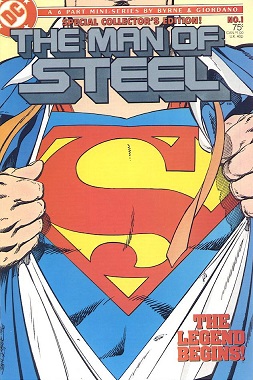
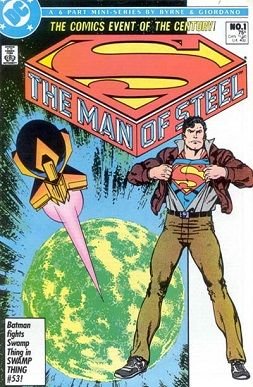
That isn't to say cover differences didn't happen prior to this. In fact it was common practice for years at both Marvel and DC for books to contain minor variations differentiating newsstand editions from direct market (mailed to the consumer) editions--newsstand copies contained a bar code within the cover box, while direct market editions often contained either white space, solicitation text for other stories (as seen in the right-hand image above advertising an issue of Swamp Thing), or simple artwork:
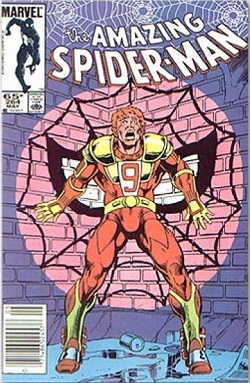 )
)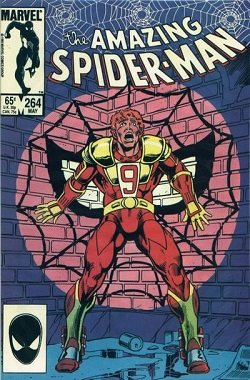 )
)But it's important to note that these differences, while necessary from both business and reference standpoints, were not intended to entice further purchases. The value of a newsstand vs. a direct market edition of the same title comes down to condition, not the presence or absence of a bar code. A true variant cover, on the other hand, is produced for the sole purpose of pushing additional sales. DC's two-cover marketing scheme is relatively benign on this front: roughly equal numbers of both versions were produced, and assuming identical condition copies, neither holds greater value than the other, and there was no drive for any but the hardcore Superman collector to acquire them both. The same cannot be said for Marvel's first major foray into the variant cover marketplace: 1991's self-proclaimed "mutant milestone" launch of 'X-Men #1', which produced no fewer than five different covers:
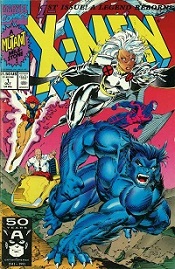
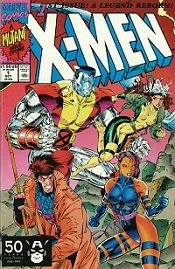
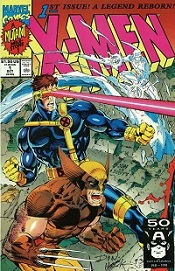
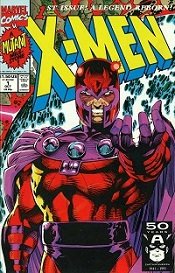
As you can see, each cover fits together with its neighbors to create a widescreen-style panoramic view of the X-Men assaulting Magneto. But you're right, that's only four covers. What about the fifth?
Well, the fifth is a single issue with gatefold panels for the front and back covers, recreating the entire spread as a solid, unbroken piece where the X-Men logo forms part of the backdrop and doesn't block any elements of the artwork, unlike the four individual issues:
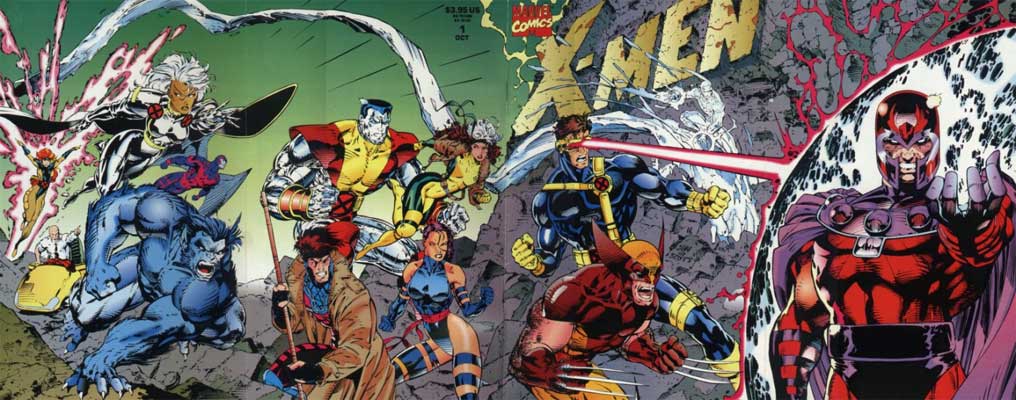
Mutant fans and collectors alike ate this up to an unprecedented degree--'X-Men #1' is the single best-selling comic book in history, with over 8 million units pushed through both retail and direct channels, and the five options were the key. The variant cover gimmick put Marvel into the record books--it was here to stay. It would take another company, an independent company, to push the variant cover to its limits. One cannot write about cover gimmicks and variants and leave out the market's most important and egregious offender.
"Image Comics" is a topic ripe for an article unto itself one day, because nowhere on Earth is the spectacle, the extravaganza, and the sheer balls-to-the-wall absurdity of 90's comics simultaneously more lovingly enshrined and harshly denigrated. Born out of passion, desperation, and desire, Image plundered some of the biggest names in writing and art from their employment at DC and Marvel, and turned them loose with instructions to create what they wanted to create with an understanding that they would retain complete creative control over any properties they birthed. While the going was slow, the nay-sayers were fierce, and not all who came on board initially remained for the long-haul, Image's business philosophy created ripples throughout the industry and changed the way many people viewed comics. Image couldn't have formed at any other time--the rising superstardom and name recognition of industry talent and the explosion in the speculators market provided the kind of market capital and investment cover necessary for the company to remain solvent through its initial growing pains.
Blasting on to the scene in 1992, Image's first book (the aforementioned Rob Liefeld's 'Youngblood #1') set order and sales records which kneecapped the naysayers and ensured Image's place at the adults' table. Subsequent books like Spawn, Savage Dragon, The Maxx, and Wetworks secured the company's position as the third-largest comic publisher after Marvel and DC, edging out Dark Horse and Viz. Most of these series used cover gimmicks to one extent or another to stand out on shelves and entice buyers, but one title in particular threw itself into the variant cover melee with all the enthusiasm of a professional wrestler elbow-dropping his way into a mosh pit: Jim Lee and J. Scott Campbell's Gen13.
Initially conceived as a five-issue limited series, Gen13 found greater-than-anticipated success during it's run from February to September of 1994. With fans, especially teens, clamoring for more of the teenage mutant team who dealt with issues closer to home than Marvel's X-Men, Gen13 was re-launched in March of 1995 as an unlimited series. Originally bi-monthly, the success off its early issues moved the book to a monthly release format starting with issue 6 in November. Part of that success, no doubt, came from the marketing gimmick which made Marvel's Mutant Milestone look positively pedestrian--'Gen13 #1' launched with one primary cover and twelve variants (for a not-coincidental thirteen different covers), and much like Pokemon, collectors had to catch 'em all:
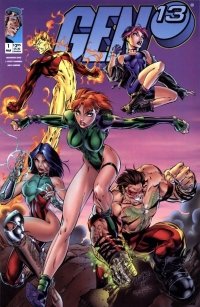
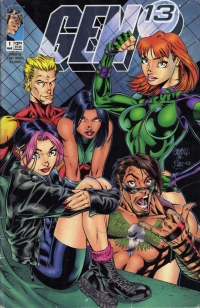
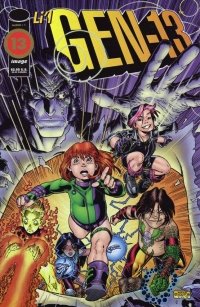
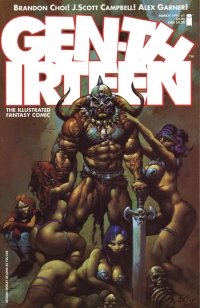
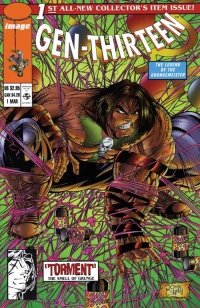
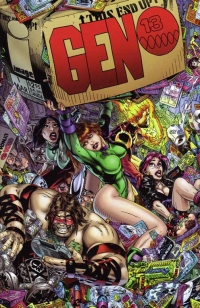
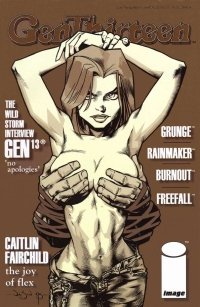
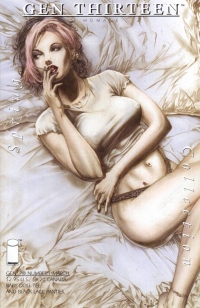
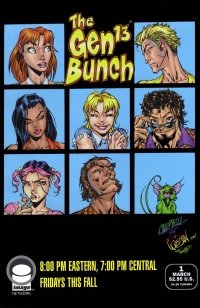
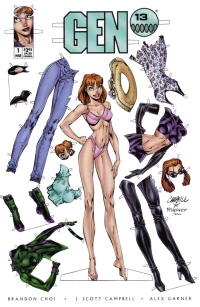
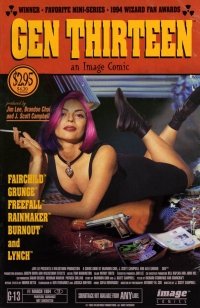
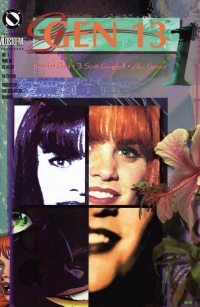
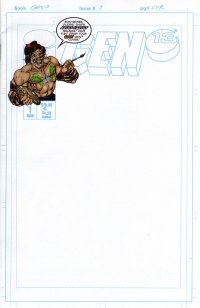
As one might expect, some of these covers were more highly in-demand than others--cover #8, dubbed 'Lin-Gen-Re', done in a style spoofing the Victoria's Secret catalog, seems to be the most sought-after for reasons I can't quite put my finger on.... What's crazier, the variations don't stop there. The second printing of the book was released with a fourteenth cover, and both Chromium and 3D editions of the book were produced as well. There are more versions of Gen13's first issue than there are issues of large-scale events like Marvel's Secret Wars, and the madness didn't stop there. Gen13's success spawned a sister book, the Warren Ellis-penned DV8, which followed a group of super-teens much like the Gen13 crew led by obnoxious bitch extraordinaire Ivana Baiul. DV8 existed to answer the question, "What if these kids were led by a sociopath and had no limits placed on the use of their abilities?". Anyone familiar with Ellis's work on other books will know the answer to be 'absolute havoc'. Three guesses as to how many variant covers of 'DV8 #1' were offered, and the first two don't count.
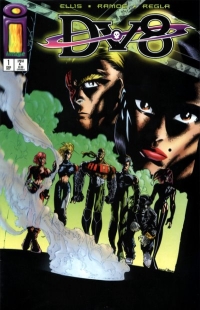

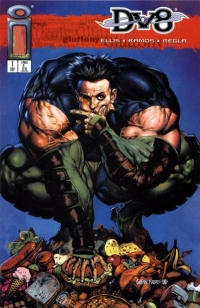
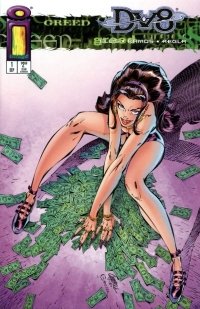
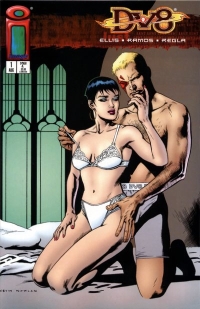
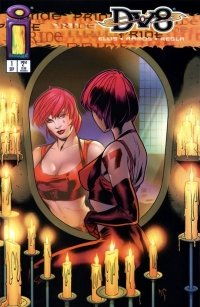
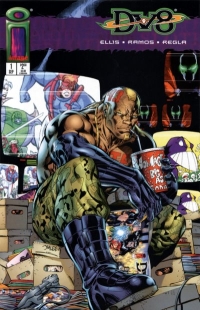
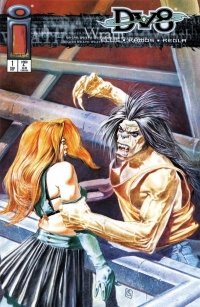
Which one is your favorite, dear reader? Answer in the comments. We'll see if a clear winner emerges.
Okay, this is a lot longer than I initially anticipated. I have plenty more ground to cover with regards to variant covers, because there are other studios who used them for an entirely different but no less mercenary purpose than those I've already covered. I'm going to end this here while I get to work researching and writing part 2.
As always, if you enjoyed what you read, smash that Upvote button like you were trying to get free soda from a vending machine. Feel free to follow me if you'd like to see more stuff about comic books, video games, and other pop culture geekiness with a decidedly 90's flair, and if you enjoy this stuff, I've got a few friends you should drop in on for more of the same:
@cryplectibles runs an excellent storefront where you can find more 90's comics than you'd believe. He blogs about some of the better books in his collection frequently here on Steemit, and offers anything he writes about for sale in his store.
@triverse doesn't do much with comic books, but he's always got his nose stuck into the weirdest and coolest stories involving video games and crypto currency. Follow him to learn stuff you never knew about retro gaming.
@darth-azrael uses his strength as a Sith to play video games, read old school magazines, and dispense with all kinds of awesome Star Wars-related geekery. The Force is strong with this one...
@gurudeva is a quiet fellow who's just as at home behind a camera lens as he is behind a keyboard or a game controller. He updates infrequently, but always has something cool in his feed.
@bryan-imhoff does more than talk about comic books, he creates them! Follow him for personal stories and updates into the creative process, or check out his other channel @spottyproduction for samples of his work.
Man, what a well researched and written article on a great topic for us geeks! And thanks so much for the shout out, I really appreciate your appreciation!
One of the earliest, and possibly laziest variant covers I remember was the release of Legends of the Dark Knight #1 in 1989. DC didn't even bother commissioning variant artwork. Those books actually had a double cover where they simply wrapped the different colored second covers around the first!
I have the hot pink one... bought fresh off the spinner rack at Waldenbooks as a kid...
Holy cow, I don't think I've ever seen these. I had no idea they existed! And I'd be hard-pressed to argue anything lazier, at least to my knowledge. Those are worse than the limited variant runs London Night did on Sheena #0, which look like wallpaper patterns of zebra, crocodile, and leopard skin respectively. You can see them here (though they'll make an appearance in part 2 of this article):
http://comicbookdb.com/title.php?ID=12714
Wow, those are pretty bad too. I'll be anxiously awaiting part 2!
On a side not, I shared this video, I think on one of @cryplectibles posts a while back and absolutely love it. Looking back for it now I realize that the Most Variant Comic of All Time arrived in shops today! This video is nostalgia gold for 90's comic fans.
Oh my god, this is GOLD! I can't stop laughing!! :D
It's funny, I grew to hate the gimmicks... but when I watch this I do realize that enough time has passed and I'm now old enough that they've moved into the realm of nostalgia. I'm ready to go out and start adding a special 90's novelty cover segment to my collection!
Not sure if you seen these bad ass covers https://www.bleedingcool.com/2017/09/07/marvel-legacy-lenticular-variant-covers/
Not sure if you heard about geeks revolting about it lol https://www.hollywoodreporter.com/heat-vision/comic-store-owners-announce-they-wont-offer-marvel-legacy-issues-1032851
Those ordering requirements are crap. If Marvel really wants to celebrate the issues, publish only the lenticular with the increased cover price I say.
My LCS did carry them, and though I haven’t picked any up I was tempted by some of the homages to classic comics of my youth!
They are super tempting. I still haven't grabbed any, but will probably get Moon Knight for myself (got a box of just Sienkiewicz that it needs to be in). Good point about just printing only those special covers. Or if anything, just the regular and the lenticular. Because at the moment they are doing the lenticulars, plus they have these Mike McKone variants going on right now too, https://www.newsarama.com/36222-first-look-27-marvel-legacy-mike-mckone-headshot-variants.html which as a sucker I dig because they remind me of those old Marvel 25th Anniversary covers that I loved
Which to bring it all back around, no way in hell Marvel would do these 25th Anniversary covers again like they did where it was everybody gets them, nope, they would no doubt just be variant covers.
I remember someone tried to sell me on barcode issues started to become more sought after. I hope that never becomes a thing. Great write up. One more really key variant I remember back in the day that was special because it helped sell an "annual" issue
Oh man, I cannot BELIEVE I forgot about that one. Thank you, thank you, thank you, @cryplectibles! :)
Iconic.
No doubt about it!
@originalworks
The @OriginalWorks bot has determined this post by @modernzorker to be original material and upvoted it!
To call @OriginalWorks, simply reply to any post with @originalworks or !originalworks in your message!
Just followed you, and all the other people you listed! Looking forward to seeing what else you post about comics!
Thank you so much, @shaungerow! I don't just focus on comics, but they're an important part of my life growing up, so I hope you like 80's and 90's stuff. After about 2002, I stopped collecting or following storylines for the most part, so it's mostly nostalgia on my end. :)
Yeah I grew up in the 1980s and 90s, so I’m pretty darn sure I’ll like it!
comics are always been awesome
This post has received a 10.58 % upvote from @booster thanks to: @modernzorker.